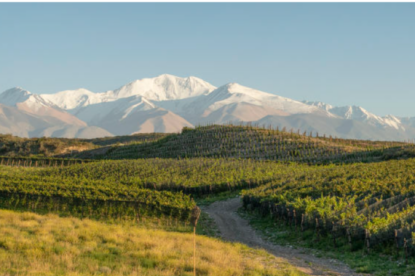The pure, joyful wines of Cariñena have long impressed royalty, writers, and philosophers. Fortunately, these Spanish wines from Aragon are being rediscovered as the popularity of indigenous grapes like Garnacha (Grenache) and Cariñena (Carignan) find favor with sommeliers and wine lovers. Behind this renaissance? One of the region’s greatest co-operative wineries, both in legacy, quality, and access to diverse terroirs, Grandes Vinos.
Grandes Vinos was established in 1997, the fusion of five co-operatives spanning all the historic growing areas of Cariñena. Recognizing strength in numbers, the groups sought to realize cross-business synergies, receiving financial support from the government and key banks to pursue them. The result: a winery that’s 700-growers strong with access to vineyards in all 14 D.O.P. Cariñena growing areas. The range of grapes, vine age, soils, and altitudes has brought incredible diversity to its portfolio.

Why a co-operative? Once misunderstood as pure volume players, consumers and the wine industry now recognize co-operatives for the integral quality role they play in strengthening communities by establishing income opportunities in the countryside. Buying wines from co-operatives inherently supports small business owners and preserves quality vines for generations to come.
Through a sustainable and democratic business model, Grandes Vinos helps independent farmers remain on their land and do what they do best—farm. Through the pooling of resources, Grandes Vinos brings state-of-the-art technology and attention to detail in winemaking and vineyard management practices. Vertical integration of production, sales, and marketing allows Grandes Vinos to bring good value, high quality wines from the vineyards of Cariñena to the global market. A win-win for all the players, especially wine drinkers.
Of course, a great business is only as good as the ingredients it’s based on, something that Cariñena enjoys in spades. The region has the most plantings of Garnacha in Spain, many of the vines between fifty years and up to a century in age. This wealth of raw material is unparalleled elsewhere in the world. Grandes Vinos, using the latest technology and scientific guidance, helps growers preserve this treasure while getting the best quality fruit possible from their mature vines.

Though Garnacha leads in plantings, the star status of Cariñena (the grape, also called Carignan), is paid homage through the name of the village and wine appellation. Yes, a grape, a wine, a town, a region—likely the only place in the world named for a variety—demonstrates the important legacy viticulture and wine have had in this corner of the world.
Blending wine, like a co-operative business, is also a quest for synergies, where the whole is greater than the sum of its parts. In addition to old vine fruit from Garnacha and Cariñena, the various soils and elevations found in Cariñena give Grandes Vinos winemakers a range of options for creating layered, complex wines.
Broadly speaking, “hot, arid, and rocky” describes the landscape of Cariñena. Below ground, however, things get interesting. Soils range from limestone, slate, red, to alluvial found from the valley floor to the surrounding foothills. To counter the hot climate, a wind from the north called “Cierzo” keeps the temperature and humidity down in vineyards, aiding vine health and imbuing wines with freshness.

With this cache of grape material, Grandes Vinos produces a range of wines and styles at different market entry points. At the top, the premium Anayón collection showcases the nuanced details of site and selection, a snapshot of terroir, vine age and variety. A historical line with spiritual roots, the Monasterio collection uses indigenous varieties to honor the Monasterio de las Viñas built by the Cistercian monks in the 11th century. The Corona de Aragón line captures the taste of higher elevation sites through old vine grapes.
In sum—or in synergy, rather—Grandes Vinos proves great wine comes from sharing, collaboration, and cooperation.
Last Updated: May 8, 2023













